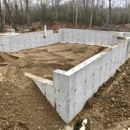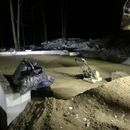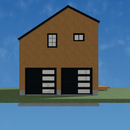Sub-Slab Insulation for Garage
I’m in Climate Zone 6 (Lakes Region of NH). I’m building a two-car garage with a 740 sq. ft. apartment above. In a separate post, I inquired about perimeter insulation, which I’m definitely going to do. I’m wondering if I should also insulate under the slab? After asking my foundation guy several times, he said insulating under the slab isn’t needed, but I’m questioning that advice. How much of a difference will it really make over and above the perimeter insulation? XPS or EPS? More details: I have perimeter drains around the foundation footings. At the moment, my dirt guy has filled up to the bottom of the slab mark with clean, compacted fill, compacted in 1 foot lifts. There will be about eight inches of foundation wall above the top of the slab when it’s poured. Would vertical insulation also be needed in addition to the horizontal insulation?
GBA Detail Library
A collection of one thousand construction details organized by climate and house part












Replies
Scott,
Commenting here as well. I think it's more of an energy optimization than an absolute requirement. You can estimate the energy use over a year, if you make some rough approximations, with and without the R10 insulation that I mentioned in the other thread. By rough I mean fantasy land, with no heat loss or gain to any other part of the universe, but it still helps show the difference.
1. The temperature of the ground is constant 50F (it changes over the season, and by depth, and stores energy over time, etc..)
2. The temperature inside is 70F, like nature intended.
3. The floor area is 725 square feet. There is an area occupied by the walls that need be subtracted, so I knocked a bit off.
Power = area * temperature difference / r value
Case 1:. Insulstion
P = (725 ft*ft) * 20 F / 10 (ft*ft*hr*F/BTU)
P = 1450 BTU/hr
Convert that to kW, you have a heat, or power loss of 0.425 kW through the slab/insulation.
Case 2: No insulation
Assume that the concrete and concrete/soil interface provide a resistance to heat flow of R1 (being generous here).
P = (725 ft*ft) * 20 F / 1.0 (ft*ft*hr*F/BTU)
P = 14500 BTU/hr
In kW,
P = 4.25 kW.
Comparing the two cases, assuming a rate of $0.10 / kW*hr
No insulation: yearly cost of 4.25 kW * $0.10 / kW*hr * 24 hr/day * 365 day/yr = $372.30
Insulstion : yearly cost of $ 37.23.
That's $335.07 saved/lost a year in energy costs, in our land of make believe. The material price for R10 is about $1/ft*ft, with some associated energy tax credits available perhaps a little less. That's $750, or about two years worth of energy savings payback. The labor involved (now) in installing it is removing the dirt, grading, recompacting, (hopefully gravel now too) compacting, laying down the insulation, and vapor barrier. The concrete isntalls the same as it would have, so no cost there. That's got to be somewhere around 40 man*hr total. I'm not sure what your labor costs for the dirt guys are, but just assume $1,500 for the sake of discussion. That's another 5 years of energy payback.
I think you're looking at a scenario where it takes somewhere in the range of 15 years to realistically pay it off. Perhaps a little more or less if some of my numbers need adjustment. What hurts the case more is that you're insulating the perimeter. That'll stop a good bit of the heat flow that would have otherwise helped the case for under slab insulation. Another is that the soil has some heat capacity, do the temperature difference will not always be a constant difference, beneath the slab.
It really comes down to when you want to spend the.money, up front or dripped along the way. That said, if you're going to own the place for the rest of your life, and leave it to your kids, it probably makes sense to do.
Kyle, this is great. Can you elaborate a bit more on your equation below? I had a hard time following it and getting your $372.30 figure. I was getting numbers off the chart. I think I was dividing and multiplying things that should not have been, but the way things were written it looked like I should. I have been looking for an equation for foam under a slab that will work. Thanks!
"Comparing the two cases, assuming a rate of $0.10 / kW*hr
No insulation: yearly cost of 4.25 kW * $0.10 / kW*hr * 24 hr/day * 365 day/yr = $372.30"
JWolfe1,
Thanks for checking my math! I knew it was too early. You're right, I'm off a decimal place.
(4.25 kW) * ( $0.10 / kW*hr) * ( 24 hr/day) * (365 day/yr) = 3,723.00 $/ year
I did that with the insulation case first by, then threw a power of 10 on it quickly instead of recalculating it like I ought to have :).
That makes the two cases, per year
Insulation: $372.00
No insulation: $3,720.00
I should have looked at that $37.20 with suspicion.
Scott,
I'll update my post to be correct*, but before I do that I hope you see this comment first.
There are a ton of other factors here that play into effect. One is that calculating that power directly assumes something like resistive heating instead of a heat pump, where the COP is greater than 1.0. Meaning, we only pay for the energy required to move energy around, and not for the energy itself. With modern (air source) heat pumps having a COP of about 2.0, we have half of those numbers,
insulation: $186.00
no insulation: $1860.00
That makes the $750 + $1500 a little more palatable. To put those numbers into perspective, my house (on the edge of climate zone 3/4) is on an uninstalled slab on grade, and my electric bill is about $140 on average. My ground is warmer through all parts of the year, but the area is larger, which shows that just a simple calculation isn't really enough to *solely* base a decision on, which is why I made that calculation in the land of make believe in the first place, ha.
Awesome! Thanks Kyle! I was getting the $3720 figure as well with the R1 scenario and thought I may have been reading the equation wrong. I appreciate you following up.
Kyle,
Thanks once again and yes, I see the latest update with the corrections. That's an eye-popping difference. With the perimeter insulation, I read that edge insulation around the perimeter would knock down about 40% of an otherwise uninsulated heating bill (percentage from this post: https://www.greenbuildingadvisor.com/article/getting-slab-edge-insulation-right).
I'm only planning to keep the garage bays just above freezing during the winter with a small modine heater (or heat pump). There's an entryway that will be walled off from the garage bays. It will be well-insulated since that entryway is open to the upstairs apartment (although I could add a door at the top of the stairs to further compartmentalize the temperatures).
Also, I'm not quite grasping what you're saying about the garage doors, but I get the general point about needing to do something for insulation around the doors.
If the garage is only going to be cooled, and minimally heated, I think the reduction in needs from the perimeter insulation probably mean that the energy savings are going to be even smaller than outlined earlier. At those temperatures, in the winter, the difference in temperature is surely less than 20F. That means you can probably take another 50% off the energy savings, and then another 40% off that from the perimeter insulation. IE, it probably doesn't make sense to over insulate an otherwise unconditioned space. I was under the impression that it was going to be heated / cooled year round to room temperature.
Kyle,
(Replying here since it looks like the replies stop at 9)
Thank you once again. Your input has been very helpful in my decision making. Yes, sorry, I should have clarified from the outside that I was only planning to keep the garage bays minimally heated during the winter (mainly to keep any plumbing from freezing, which will be run above the garage bays and then out through the sewer pipe, which is tucked in the corner of one of the bays).
It seems the best bang for my buck and the best insurance is to put down the vapor barrier on top of the prepared fill (I got 15 mil Stego Wrap today) and the perimeter insulation on the outside of the foundation walls. I'm feeling pretty good about that combo as a solid long-term approach. Better than doing nothing at all.
Thanks again for your help! Much appreciated and happy holidays.
That sounds like a good solution to me as well.
Keep us updated on the progress every now and then!
Kyle, thank you so much for putting it into quantitative form. Very helpful. I'm hoping I can put in place other insulation efficiencies with the walls, etc. At a minimum, I've decided to put down a 10+ mil true vapor barrier (not retardant) below the slab.
You're welcome.
By the way, one area you may want to start thinking about right now, is the exterior door (36") in the garage. With insulation coming up from underneath, you may run into an odd scenario where the threshold is only partially supported by the concrete, and the rest extends over the insulation, without a good way to cap it off.
FYI, Eversource's current charge per kilowatt hour is just about $0.18, which will shift the payback period numbers a fair bit.
That price includes $0.083/kWh for electric supply and $0.098/kWh for distribution/transmission/stranded cost recovery/other fees.
Hi all and happy new year!
Here's an update. Since my foundation contractors had slack in their schedule, I enlisted their help with the perimeter insulation and finishing the drains. Had to redo one side of the drains, but the result is better this time. The walls are all prepped for perimeter insulation (thanks for input from some of the same folks here on a different thread). Insulation arrived today and drains got finished today as well. Insulation will get installed on Monday and the remainder of the backfill done. I would have liked to have found EPS insulation, but could not find local sources. I also wanted the new Dupont Gray Board (Beyond Blue), but apparently it's not shipping for at least a month or more. No distributors in NH, ME, VT or ME had it, that I could find.
Regarding the slab, that won't get poured until after the framing is done so that we can keep the ground under the slab warmer. Framing should start third week in January. No under slab insulation, but still the 15 mil barrier. I feel pretty good about the solution with perimeter insulation and the vapor barrier. Should result in continuous insulation on the exterior with the siding so that there's minimal thermal bridging.
Happy New Year too, FWIW, I'll park this info on your post ;-)
https://engineer-educators.com/topic/7-heat-loss-from-basement-walls-and-floors/ covers basements and slabs.
Basements: "The temperature of an unheated below-grade basement is between the temperatures of the rooms above and the ground temperature. Heat losses from the water heater and the space heater located in the basement usually keep the air near the basement ceiling sufficiently warm. Heat losses from the rooms above to the basement can be neglected in such cases. This will not be the case, however, if the basement has windows."
Slabs: "Many residential and commercial buildings do not have a basement, and the floor sits directly on the ground at or slightly above the ground level. Research indicates that heat loss from such floors is mostly through the perimeter to the outside air rather than through the floor into the ground, as shown in Fig. 39. Therefore, total heat loss from a concrete slab floor is proportional to the perimeter of the slab instead of the area of the floor"
For others considering options for insulating under slabs, I just spoke to a rep at Glavel today about plans for a garage of my own. Glavel expects to begin shipping foamed glass from their VT plant this quarter (Q1 2022).
My personal thoughts on insulation under my own will-probably-only-need-minimal/occasional heat garage that I’m planning is this: With Glavel doing double duty as capillary break, aggregate fill, and insulation, why not take advantage of the insulation benefits at a small incremental cost just in case some day I, or someone 30 years from now, wants to use it as a workshop or otherwise convert it to a heated space? You only get one chance to insulate under the slab. Without sounding too much like a shrill for Glavel, the product makes doing this much more attractive.
Point of fact, I’m living in a slab-on-grade house now that was originally built 110 years ago as a garage / carriage house. Too bad they didn’t put insulation under the slab then. ;)
Scott L.,
That's very cool, thanks for the tip. I will check it out. I have time to rethink whether to insulated under the slab. I imagine it would still need a vapor barrier on top. I priced it out according to the October GBA post about Glavel ($65/cubic yard) and it would be a cost-effective alternative to rigid insulation.
$65/yd is cheaper than I was expecting to hear, after reading the article. What is washed #57 a yard in your area?
I chose not to insulate under the slab in my Vermont garage (only around the perimeter) figuring that because I plan to keep the garage at about 35 degrees during the winter, the ground below the slab is warmer than that and thus an uninsulated slab helps heat the garage rather than requiring more heat.
Was I wrong?
Depends on if/how much you insulate the rest of the building.. I've got a 2 car garage in Central NY. The ceiling is insulated to about R15, but the walls aren't, it uses modern insulated double hung windows, and doors.
Most of the winter water will freeze on the floor.
That makes sense. My garage is under a heated room and has insulated walls. Even in Vermont the garage temperature seldom falls below freezing. My theory is that because the slab is not insulated and the ground temperature is above freezing, then the ground is contributing some heat to the garage, and thus I am better off not insulating under the slab.
You have made the assumption on your heat losses that the temperature under the slab will be ground temperature or 50F even with indoor temperature of 70F. Big problem is that is not how heat loss through slab works. Assuming garage is heated (to 70F, really?) the ground temperature immediately under the slab is no longer going to be 50F, but there will exist a temperature gradient with depth and the soil will be much warmer right under the slab reducing the heat loss. Of course near the slab edge is different as there the loss to to outside air. As a result your estimated savings are way too high, although heat loss will certainly be reduced some by under slab insulation.
My feeling is that you will have so much air leakage through the garage door, as well as conductive heat loss through garage door (make sure on garage door you are looking at effective R value, not just the R value of insulation panels) that you are wasting money on under slab insulation in a garage. I think a more reasonable approach would be to plan on the garage to be heated to something reasonable like 50 to 60F in winter and put some insulation in the garage ceiling to keep it warm upstairs.
"By rough I mean fantasy land, with no heat loss or gain to any other part of the universe"
I think everyone was well aware with the limitations of the assumptions. And it has been stated in other replies that the garage is to be unheated.
Below is a finite element analysis of heat loss under a slab. This shows a heated slab (radiant in-slab heat) but same idea if heat if from above the slab. Look at the temperatures under slab in both cases. Not a big difference in middle of slab, but enough if concerned about occupant comfort or energy loss for radiant heating. For a garage? I would forget it. Your slab edge insulation is more than enough.